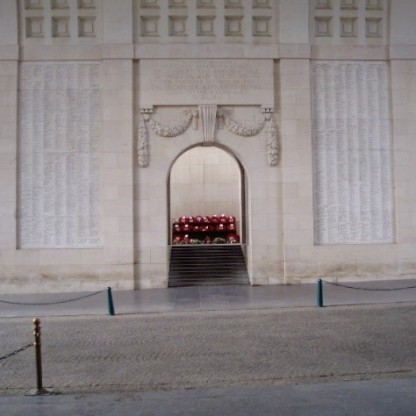George Kirk was born in Old Whittington in 1895. He was the eldest child of George and Ellen.
In 1901 the census shows the family are living at 94 Johnson Street Old Whittington.

Johnson Street was in the area known as The Brushes.

Photo courtesy of Chesterfield Local Studies Library.
On the census of 1901 George’s mother is listed as the Head of the household, but still classed as married (not widowed). I managed to trace George’s father who in 1901 was listed in Devonshire Hospital Buxton. There is no way of knowing now why George senior was in this hospital but it was opened as a hospital in 1859 to look after the ‘sick poor ‘who were arriving from the cotton works in Lancashire and Yorkshire. It closed in 2000 and was one of the last hydropathic hospitals in England. The ‘water cure’ was believed to help with pain relief and many other ailments.

Devonshire Hospital Buxton picture source here
There is not much information for George unfortunately and the next record I can find is the 1911 census.

George’s father has returned home and is working as a joiner at the Coal and Iron Co (Sheepbridge Works). George is now 16 and is working as a pottery labourer. There were several potteries in the area, there was one on the Brushes and Pearsons Pottery on Whittington Moor.

Map showing the Brushes Pottery on Sheffield Road picture from here
George now has three younger sisters. Jane born 1905, Mary born 1906 and Agnes born 1908. The family are still living at 94 Johnson Street.
Little more is known about George until he joined the 10th Battalion Nottingham and Derbyshire Regiment (Sherwoods). His service number was 15170.
The 10th battalion were sent overseas in July 1915 and George was with them, landing in Boulogne on 14th July 1915. 10th battalion were under orders from 51st Brigade in 17th (Northern) Division. The division spent the initial period in France in trench familiarisation, after this they spent most of their time holding the front line in the southern area of the Ypres Salient.
The Ypres Salient was formed by British, French, Canadian and Belgian defensive efforts against German incursion during the 1914 “Race to the Sea”, culminating in the Battle of the Yser and the First Battle of Ypres
Taken from http://www.wikiwand.com/en/Ypres_Salient
Map of the Ypres Salient

Picture and further information http://www.wikiwand.com/en/Ypres_Salient
The war diaries for February 1916 report:
The Battalion were at rest in Houlle 1st -4th with customary training. On the 5th they were to move up to the trenches. Part of the journey was by rail, then they marched to Poperhinge. Days later they were in front line trenches and in the thick of it. The night of the 13th/14th February the 10th Sherwoods relieved the 7th Lincolnshires and all 4 companies occupied the front line and support trenches, as far as I can check George Kirk would have been with them. It was reported the night was quiet but at 8.30am the enemy commenced intermittent bombardment which continued until 3.30pm, when the enemy then commenced a terrific bombardment.
A message was sent to Brigade HQ asking for as much retaliation as possible! Retaliation commenced at 4pm but was inadequate and poor in comparison, the Battalion could not impress the seriousness of the situation. The Company Commander decided it would be futile to send up any more men.
“The Germans, preceded by a large number of bombers, who from some accounts were dressed in khaki with white bands on their right arms, jumped into our frontline trenches as the guns lifted and must have been well across ‘No mans land’ before the bombardment lifted. Facing little resistance the enemy managed to advance as far as the communication trenches but got held up by the Sherwoods in the support trenches”.
The trench system was laid out as :
Front Line trenches nearest to No mans land.
Support trenches approx. 75 metres behind the front line.
Reserve trench approx.. 300 metres behind the support trench.
Communication trench ran perpendicular to the front line, support and reserve trenches.
This gives an idea of how far the enemy infiltrated the trenches during what must have been an horrific fight, and one which George was quite possibly involved in.
More information on the trench system – https://www.longlongtrail.co.uk/soldiers/a-soldiers-life-1914-1918/life-in-the-trenches-of-the-first-world-war/
George died sometime on 14th February 1916. Like many of his fellow soldiers his body was never recovered and he is commemorated on the Menin gate memorial in Ypres. He was approx.21 years old. Information on the Menin Gate Memorial can be found at

Grave registration
George was awarded the Victory, British War and the 14/15 Star medals.

George’s father died in 1921 and George’s personal effects were sent to his mother Ellen as his next of kin.
Georges sisters all went on to marry Whittington men. Jane married Joseph Tomlinson at Old Whittington church on February 13th 1928, her sister Mary married Richard Holland at Old Whittington church on 12th April 1930, and Agnes married Robert Simms towards the end of 1930. The 1939 pre-war census shows Agnes and her husband living in the family home at 94 Johnson Street and also listed there is Ellen, Georges widowed mother. Ellen died in 1949.
George Kirk is remembered on the Old Whittington and the Brushes War memorials.



